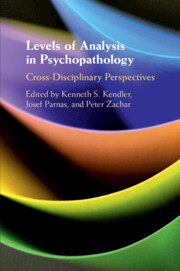Book contents
- Levels of Analysis in Psychopathology
- Advance Praise for Levels of Analysis in Psychopathology
- Levels of Analysis in Psychopathology
- Copyright page
- Contents
- Figures
- Tables
- Contributors
- Preface
- General Introduction
- Part I Neuroscience, Mechanisms, and RDoC
- Part II Phenomenology, Biological Psychology, and the Mind–Body Problem
- Section 4
- 10 Introduction
- 11 Body Self-Awareness: Multiple Levels or Dynamical Gestalt?
- 12 Commentary on Gallagher “Body Self-Awareness: Multiple Levels or Dynamical Gestalt?”
- Section 5
- Section 6
- Section 7
- Part III Taxonomy, Integration, and Multiple Levels of Explanation
- Index
- References
10 - Introduction
from Section 4
Published online by Cambridge University Press: 02 April 2020
- Levels of Analysis in Psychopathology
- Advance Praise for Levels of Analysis in Psychopathology
- Levels of Analysis in Psychopathology
- Copyright page
- Contents
- Figures
- Tables
- Contributors
- Preface
- General Introduction
- Part I Neuroscience, Mechanisms, and RDoC
- Part II Phenomenology, Biological Psychology, and the Mind–Body Problem
- Section 4
- 10 Introduction
- 11 Body Self-Awareness: Multiple Levels or Dynamical Gestalt?
- 12 Commentary on Gallagher “Body Self-Awareness: Multiple Levels or Dynamical Gestalt?”
- Section 5
- Section 6
- Section 7
- Part III Taxonomy, Integration, and Multiple Levels of Explanation
- Index
- References
Summary
If you ask the question “where is the mind located?” or “where do consciousness and cognition take place?” a typical answer from the layperson and most of the neuroscientists will be “in the brain” or “in the skull.” This is a usual view of our mentation: It is produced by the brain and is therefore confined to the skull. This theoretical perspective is frequently called “internalism.” Sometimes it is also called “Cartesian materialism”: The brain and its world are in a constant energetic exchange. The information that impinges on the brain comes through the sensory channels as physical or chemical stimuli. This is all that we know directly about the world.
- Type
- Chapter
- Information
- Levels of Analysis in PsychopathologyCross-Disciplinary Perspectives, pp. 129 - 130Publisher: Cambridge University PressPrint publication year: 2020



